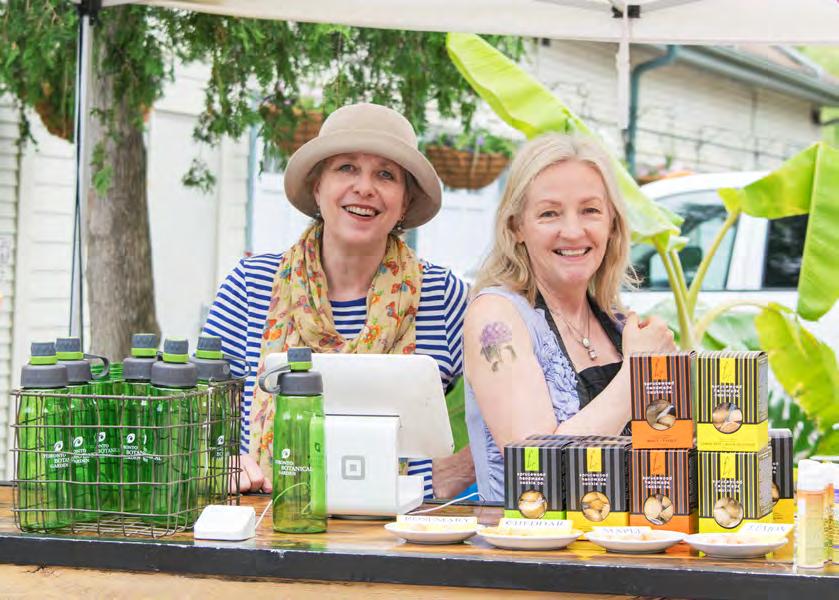
4 minute read
Book Shelf
Book reviews on all aspects of gardening from a Victorian invention to growing outside in winter to understanding the lingo

The Wardian Case A simple box that changed the world Reviewed by Sonia Day
THE WARDIAN CASE. Is it a recently-discovered Sherlock Holmes mystery that no one knew about? Or perhaps a rare instance of a patient surviving some ghastly fatal disease?
Neither. In fact, The Wardian Case was nothing more than a simple wooden box. Yet it’s no exaggeration to say that this box literally changed the world we live in. Now an Aussie environmental historian named Luke Keogh has chronicled its remarkable history in an entertaining new book.
If you’re a sucker for tales about early plant explorers (as I am) this is an eye-opening read. It made me realize the debt we gardeners owe to Nathaniel Bagshaw Ward, a medical doctor and amateur botanist who devised the box (a forerunner to the modern terrarium) to help plants survive in the dirty air of Victorian London. Ward found that ferns would last for years–without water or nutrients–if planted in closed boxes which had glass sides. His ‘Wardian Case’ wound up catching on in a big way, moving thousands of plants between continents, usually on decks of ships. Tea, which originated in China, went to India where it became a huge crop. A similar thing happened with bananas sent to Samoa and the Caribbean. Dozens of beautiful garden plants that we now take for granted–like roses, rhododendrons, magnolias, wisteria, countless ferns and more–travelled thousands of miles from their countries of origin in these unpretentious but surprisingly efficient boxes.
Predictably, all the botanical bustling about the globe had a downside. Invasive species spread too and the soil used in the boxes transported myriad diseases and bugs. But what happened makes a great story, and Keogh tells it well. The photos are also fascinating. The Wardian Case. How a Simple Box Moved plants and changed the world (University of Chicago Press, 2020.)
Sonia Day is a former Toronto Star gardening columnist. Her second novel, The Mexico Lunch Party, is being published by Olympia this year. More at soniaday.com

Growing Under Cover
Yes, you can grow veggies in winter Reviewed by Georgie Kennedy
ARE YOU UNDER the illusion that you don’t have the perfect space to grow veggies all year long in our cold Toronto climate? What if I told you that you do have the right place and it’s simple to make it work? Have you ever thought about creating a covered garden outdoors so that you can give seeds the correct light, temperature, water and nutrients they need to become luscious tomatoes, spinach and parsnips?
I fell headlong into Niki Jabbour’s latest how-to picture book, Growing Under Cover, imagining my own greenhouse and planning my own mini hoop tunnels. Canadian gardening superstar Jabbour has taken her well-documented experience with cultivating food in Halifax, Nova Scotia, to a new level in this publication. She provides clear answers to every single question that a prospective vegetable gardener could possibly have.
The book offers advice and cautions to both novices and experts as they navigate the decisions needed to make before building their beds, and follows up with clearly illustrated directions for construction. The second half of the book is devoted to growing vegetables protected as organically as possible, using vertical space.
If you have a yard of any size, this book is an easy-toread guide, whether you plan to start small with cold frames or go large with a professionally installed greenhouse. Niki’s insights will help you consider everything from choosing and preparing the site to dealing with humidity and pests. The layout, with its colourful sidebars and personal notes, appealed to me because it revealed the genuine enthusiasm of the author. Growing Under Cover, (Storey Publishing, 2021)
Georgie Kennedy is a Toronto Master Gardener, a garden writer and an avid caretaker of her gardens in Toronto and Jamaica.

A Botanist’s Vocabulary
1,300 terms explained and illustrated Reviewed by Carol Gardner
IF YOU’RE OFTEN bewildered by botanical terminology, this is the book for you! A Botanist’s Vocabulary is written by Susan K Pell, who has a PhD in plant biology and an impressive work history.
The book contains 1,300 botanical terms, listed alphabetically—from abaxial (lower surface) to zygomorphic (having a single plane of symmetry such that only one line drawn through the middle produces two mirror image halves).
The fact that there are excellent illustrations by Bobbi Angell goes a long way towards understanding the explanations, which are not always easy to fathom if you’re not a botanist. As an example, here’s a definition of capsule— “1) Dry, dehiscent multilocular fruit splitting open along one to many lines or locations of dehiscence —may be circumscissile, loculicidal, porcidal, septicidal 2) The spore-containing structure (sporangium) of mosses”
As a comparison, I looked up the definition of capsule in the New York Department of Horticulture Glossary of Horticultural terms and found this— “Simple, dry, dehiscent (see definition of dehiscent) fruit with two or more locules (the cavities of the ovary of the pistil of a flower) which split in various ways.
So, I can’t help feeling that this author sometimes aims to impress rather than to educate.
Notwithstanding the above, A Botanist’s Vocabulary will definitely increase your horticultural vocabulary and understanding. Moreover, as Agatha Christie’s sleuth, Hercules Poirot, would say, it’s a good workout for your ‘little grey cells’. A Botanist’s Vocabulary (Timber Press, 2016)
Carol Gardner is a long time TBG member and volunteer and a freelance garden writer. She is Chair of the Trellis and the Through the Garden Gate committees.









